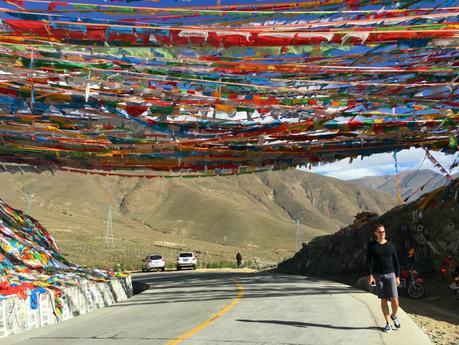
Until I started posting pictures of our time in Lhasa on various social media platforms, call me naive, but I hadn’t realised just how much this spot, tucked high up on the northern side of the Himalayas was shrouded in mystery. Few people I know have travelled to Tibet and few are familiar with its rocky, rugged mountain-scape, vibrant city landmarks and peaceful and relaxed culture.
Only open to tourists since 1986, people are clambering for an insight into this faraway land, which while it has been at the centre of a territory dispute for decades is still largely unknown territory.
Today, an autonomous region of China – for obvious reasons, I’m not going to get political in this post, other than to say we were welcomed by all of the locals (Tibetan and Han Chinese) with open arms and smiling faces.
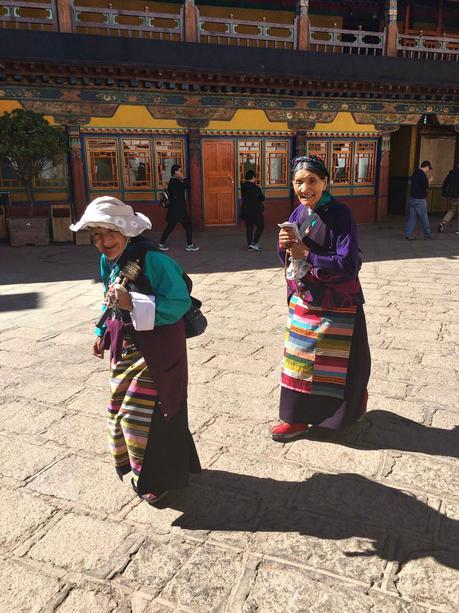
Instead, I’ll try to paint picture of what, for us, was an incredible, once in a lifetime experience at the place they call “The rooftop of the world.”
First, a few quick facts: 90 per cent of people in Tibet are ethnic Tibetan Buddhists. They have roamed this harsh and unique part of the earth for some 21,000 years. Tibet is on the Tibetan Plateau, the highest region on earth and spans over 1,200,000 square kilometres! Comparably its population is small. Just over 3-million. Lhasa is the capital and stands at 3,610 metres above sea level. (That’s 11,840 feet!) Mount Everest the world’s tallest mountain holds stake on the border of Tibet and Nepal and is about 700 kilometres away from Lhasa, (so no, unfortunately we didn’t make it to the mighty mountain).
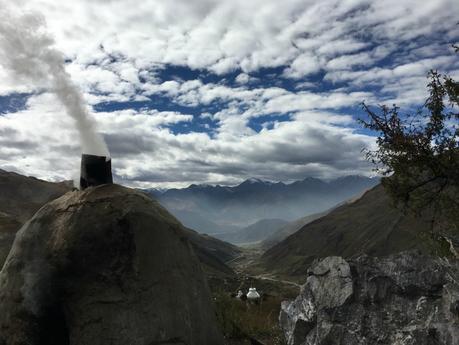
Despite, many articles encouraging us to catch the train to Lhasa, in order to acclimatise along the way for our Tibet tour — experienced and long time visitors to Tibet, insisted flying would be less taxing on our bodies, therefore making us less susceptible to altitude sickness.
Because of its height above sea level, the air is thinner, leaving you less oxygen to breathe (In fact: Once you move above about 13,000 feet, oxygen levels are only sixty percent of those at sea levels) and our bodies need to make a lot of changes to cope with this new environment.
So with time of the essence we were happy to take the three hour flight from Xi’an.

As we drew closer to Lhasa, peeking out the aeroplane window had me in awe; jagged, mountainous ranges stretched out for miles before us in all their golden glory!
Arriving at the airport was reasonably straightforward; after collecting our bags, we were ‘scanned out’ of the airport by local military. Here we had to show our permits to tour in Tibet. No one is allowed in the arrival area, so our tour guide ‘Lobsang’ was waiting patiently outside for us.
To tour Tibet, you must have a permit and a tour guide with a pretty solid itinerary from the travel agent – but I’ll explain more on that later.
Outside, we were immediately taken aback by the blinding sunlight and the brilliant, piercing blue sky. Standing on the roof of the world felt fresh and despite the crisp autumn temperatures, the sunshine was warm on our shoulders.
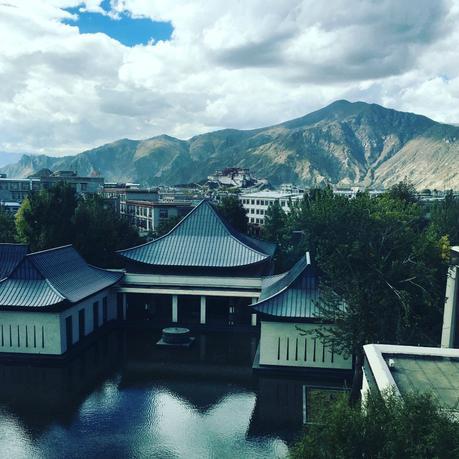
The drive to Lhasa was about forty minutes and to my surprise, the entire way, craggy, boulder-like mountains flanked either side of us.
We went smoothly through one military check point, where our passports and permits were checked and then on to the city. At first glance, Lhasa didn’t seem too different to other cities we’ve experience in China. Three wheeler Tuk Tuks, motorbikes piled high with people and paraphernalia, street stalls, ramshackle laneways and neon signs (the one obvious difference, Tibetan writing on the top and Chinese on the bottom).
It didn’t take long though, to work out, that beneath the surface, Tibet is an entirely different kettle of fish.
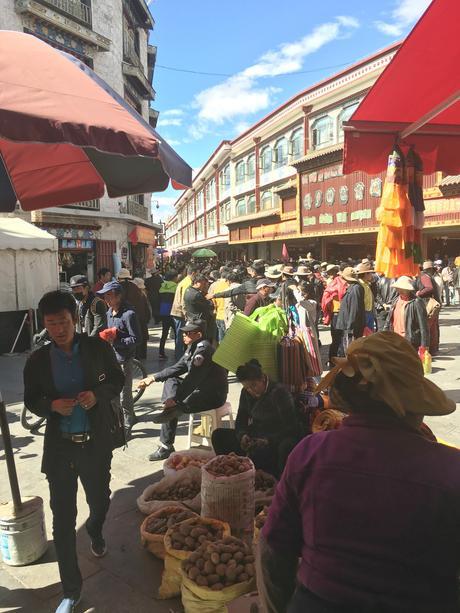
Apart from hotel brands, there are virtually zero western brands; the likes of McDonalds, Starbucks etc that you see cropping up all over China are yet to penetrate this peaceful plateau.
We were welcomed with a small traditional ceremony, including being gifted these white, silk prayer scarfs (the first of many we came across)!
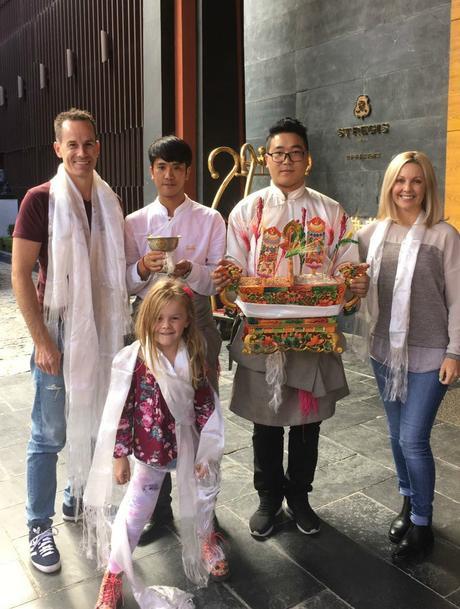
To combat altitude sickness we were advised to take it very slowly on the first day. i.e use as little energy as possible! This meant we got to hang out in the hotel for the entire afternoon.
Clearly I’m no expert, but altitude sickness is definitely not to be taken lightly. People have become very sick and some have even died.
There seems to be no rhyme or reason as to who is affected and who isn’t; gender, age and fitness seemingly have no bearings on your ability to cope. Ultimately you need to listen to your body and abide by the rules….go slow, no drinking or smoking for the first 24 hours (at least), no shower or bath on first night (because apparently this uses more oxygen) and drink plenty of water, in fact, double the amount you would normally have. (Oh and don’t be alarmed at exploding deodorant bottles and/or the like.) 😉
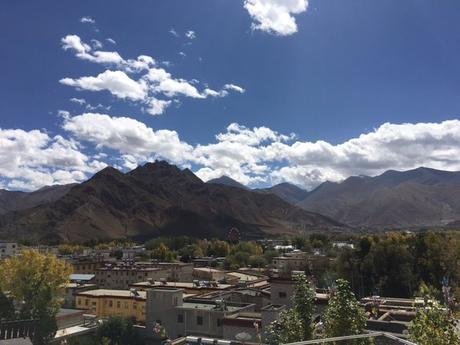
In most hotel rooms you should find oxygen and while some experts advise only to take this if you feel sick (headaches, nausea, dizziness etc) we were advised by some long timers to take it before, as a precaution, so that we did! (With no drinking on holidays, what else is a girl to do!! 😉 )
We also took altitude sickness tablets, given to us by our reputable Hong Kong doctor. (These are called Diamox.)
They’re not for children, but doctors say children tend to suffer less from altitude sickness. (In fact, a new study published in the journal, Paediatrics, suggest that otherwise healthy children’s symptoms are usually pretty mild.)
In our Small Person’s case, thankfully this appeared to be true. She was firing on all cylinders, at all times!
As for the Tibetans? Research reveals they have a ‘super athlete’ high altitude gene to cope.

It’s another striking day, the sky a deep, deep blue with puffy white clouds skidding across the roof of the world.
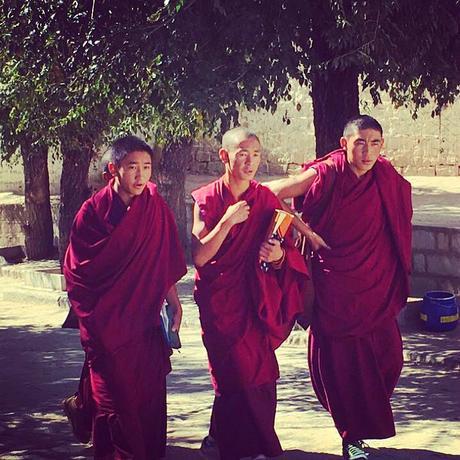
First stop, the Sera Monastery. Found in 1419, it’s also known as the “Wild Roses Monastery” it’s one of the “great three” schools of Tibetan Buddhism. (A Gelugpa Monastic College, for those in the know and like many of Tibet’s monasteries has undergone rebuilding and renovations over the years.)
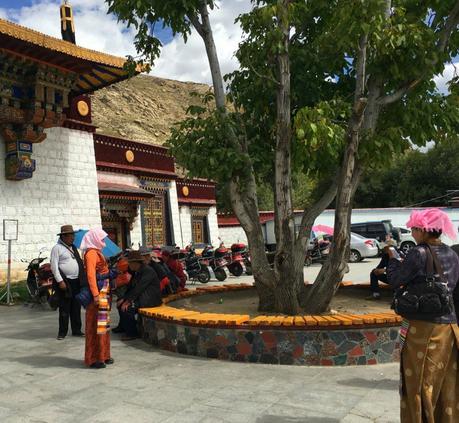
Arriving, it feels like we really have been transported to another world. Many local women are dressed in their colourful, traditional Tibetan costumes, which we soon find out is par for the course across the city. (The colourful, striped woven aprons signifying ‘marriage’.)
Monks roam randomly (and in what is a slightly bizarre sign of the times, many are carrying mobile phones).
Everybody seems keen to touch our small person and grab a picture of her. If we thought the paparazzi action in Xi’an was intense, this is even more so! For all intents and purposes, few foreigners come to Tibet, especially small ones. Like it or not, Ava is thus the star attraction.
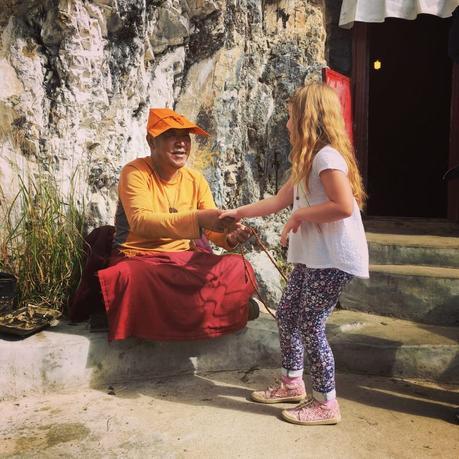
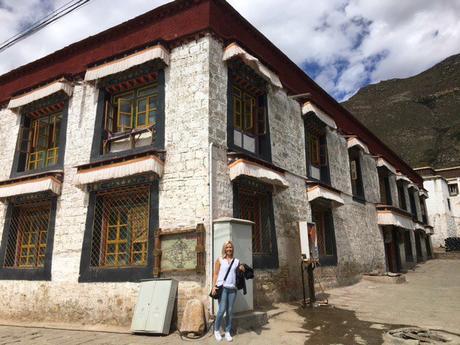
As we amble up the small slope, I feel myself a little out of breath, puffing a little heavier (due to the altitude)… but it’s the sights and sounds that literally take our breath away.
Dozens of wild, mangy dogs lie lazily at the front of the Monks’ quarters which are almost European looking with their ivory stone with bright yellow awnings.
Apparently it’s the only place the canines can get a decent feed and are looked after.

We follow the crowds of locals and tourists who are heading up in their droves to the temple. We notice many of them on the way back down have strange ‘black marks’ etched down their noses or across their foreheads. Mostly the children. A little further up and there’s a queue stretching back around the block of the main temple. Here we’re told pilgrims come to see the main image in the monastery known as Tamdrin or “Haryagriva” (the horse-headed deity). The mark is from the butter light lamps and is a blessing from the Haryagriva. It’s believed this will bring children a long and healthy life (and ironically help them sleep soundly at night). Of course, I try desperately to convince my small person to have a go, but she isn’t having a bar of it! (Five years of rough sleep? What’s a few more she says!). She does, however convince us to buy her, her own ‘special’ necklace in the temple and appeases us with a few pics with the ‘blessed’ kids.
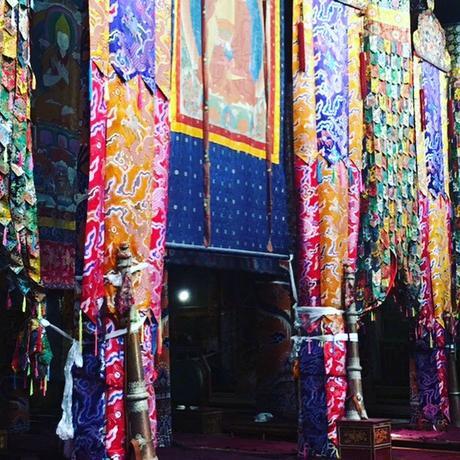
Inside the temple, stunning golden statues shine brightly in the dimly lit halls, the smell of smouldering incense wafts into the air and brightly coloured cloth drapes from pillars. Lobsang proudly shows us what are treasured scriptures written in Tibetan and printed on wooden blocks covered with gold powder and engraved with red lacquer, locked safely in a tall glass case before us.
I spy the Monks’ rich red robes left idle on the bench seats – it’s as if they’ve just been shrugged off after prayer time.
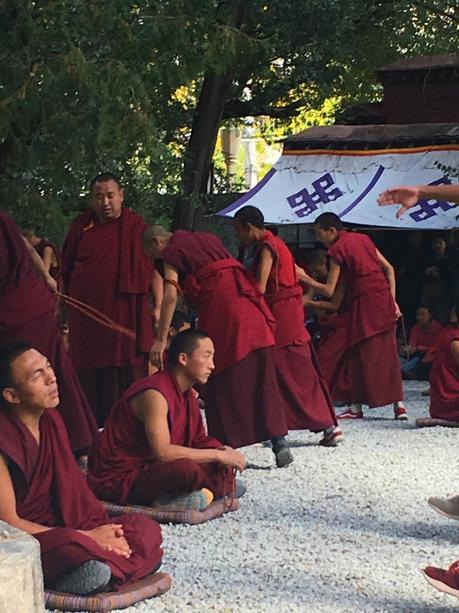
Stepping outside the temple and into the main courtyard, we stumble across what looks like some sort of ringside show. Crowds of people are gathered around the outside of the courtyard, eagerly watching on. We perch on the edge and see about one hundred monks in pairs, chanting animatedly with each other, along with what looks to be a ‘slapping’ frenzy!
We discover it’s ‘debate time’ (and fortunately, they’re not actually slapping each other). This is a highlight, strictly unique to this monastery. Young monks in training come here most afternoons to debate with each other in what is considered integral to learning the Buddhist philosophy. Intrigued we watch this strange but captivating routine take place for about 15 minutes.
Lobsang tells us that while there used to be around 5000 monks at the monastery, the numbers have dwindled to around 500.
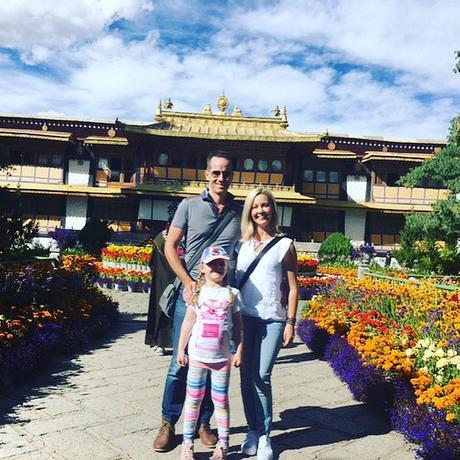
Next stop is the Summer Palace or ‘Norbulingka’ or the Jewelled Park. Built for the 7th Dalai Lama in the 1700’s, we’re told it later became the summer home for all successive Dalai Lamas, including the 14th and current Dalai Lama until his exile in 1959. Blossoming with flowers in every hue, the palace has a garden area of around 360,000 square metres. It’s the biggest man-made garden in Tibet!
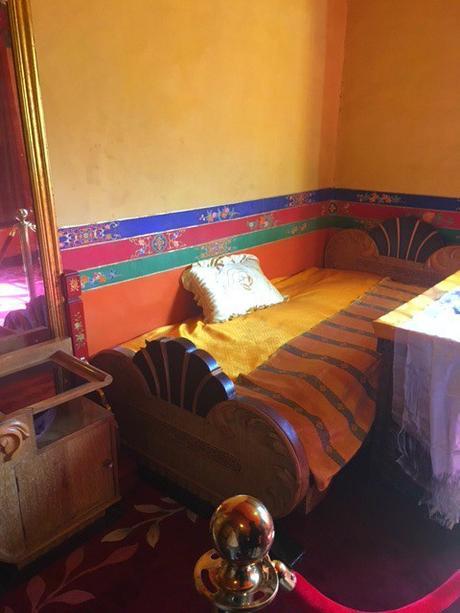
Inside there are 374 rooms, from halls for worshipping Buddha, to reading rooms, meditation rooms, business rooms, bedrooms and bathrooms, which are all ablaze with vivid colours, from floor to ceiling! We are privileged to see where the Dalai Lama slept and the small person exclaims loudly how small his bed is!
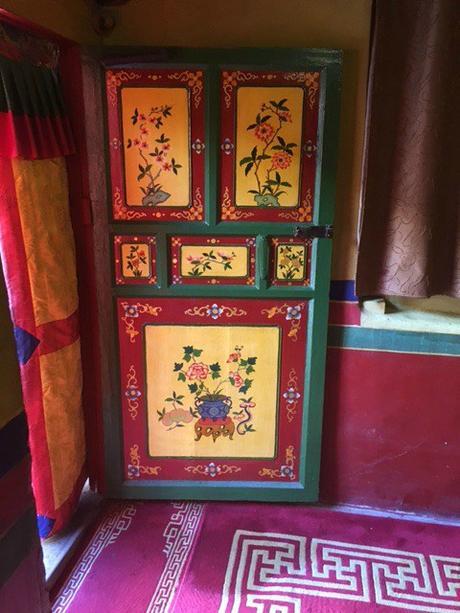
In Tibet, it soon becomes evident that colour holds huge significance and each of the five primary colours (blue, white, red, green and yellow) hold specific meanings. Known as the Five Pure Lights, each colour represents a state of mind, a celestial Buddha, a body party and a party of the mantra word Hum. Hence the thousands of colourful silk prayer flags that make a vibrant and frequently-seen sight across the city!
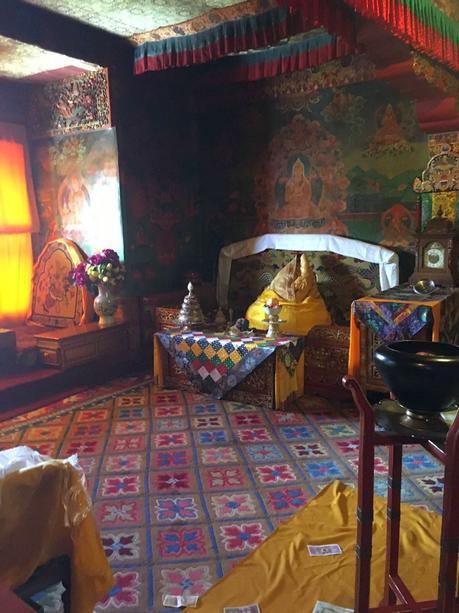
We enjoy a quiet evening on the hotel balcony overlooking the magnificent Potala Palace, in preparation and anticipation of climbing it the next day! Lobsang tells us to reserve our energy for the 300 steps!
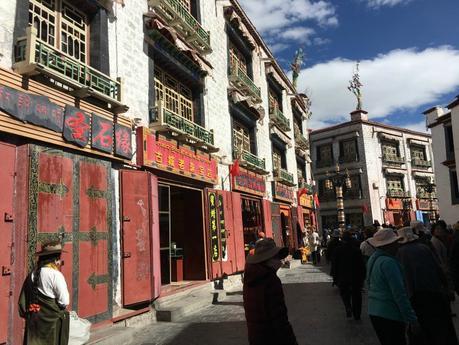
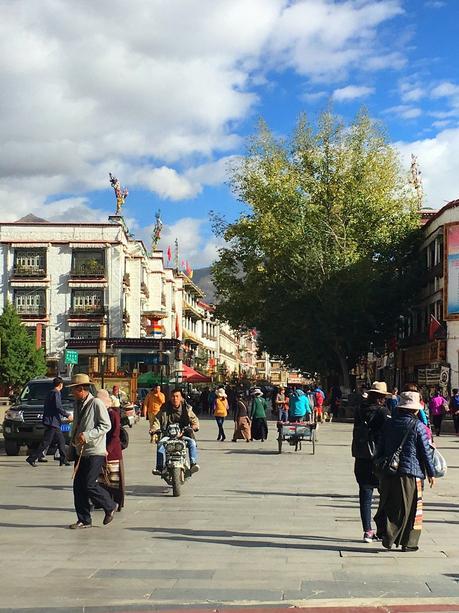
Day 3: First up though, the famous Jokhang Temple. Just when you think you’ve possibly seen enough temples, we’re pleasantly surprised! They’re all uniquely different and incredible spectacles in their own right. Jokhang is down in the centre of the city near the Bazaar markets in Barkhor Square, which gives us firsthand experience of the locals in action. The square is buzzing with people… many of them spinning prayer wheels and prayer beads, softly humming mantras to themselves…..and for us, it’s hard to know where to look! Every which way is a sight to behold.
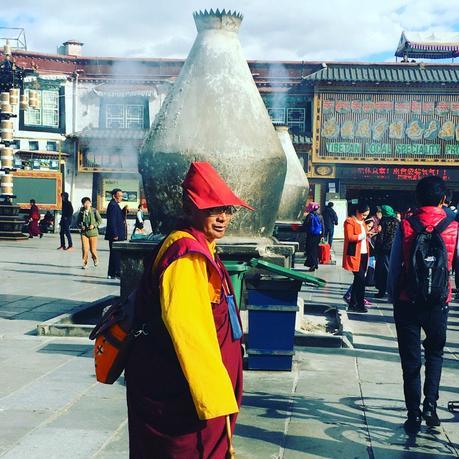
This tall, multi-coloured prayer flag a monumental city centrepiece!
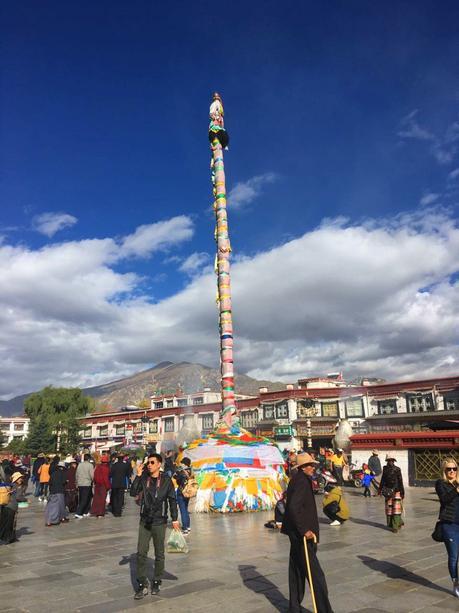
Jokhang Temple is considered the most sacred and holiest site in Tibet — built for King Songtsen Gampo’s two wives (one Nepalese and one Chinese) the King is credited with first introducing Buddhism to Tibet.

Outside hundreds of pilgrims gather for prayer time, many of them doing what are called ‘full-body prostrations’. They take three steps, stop, get down on their knees and then their hands and stretch out flat on their stomachs, touching their foreheads to the ground, before standing back up. Some do as few as three, some as many as 500 per day. Everyone has their own mat, and on their hands, blocks to make sliding easier. The women’s legs are tied near the bottom, no doubt making for easier sliding. Not for the faint-hearted it looks like an energetic task, but at the heart of it is a deep spiritual practice to purify the bad karma.
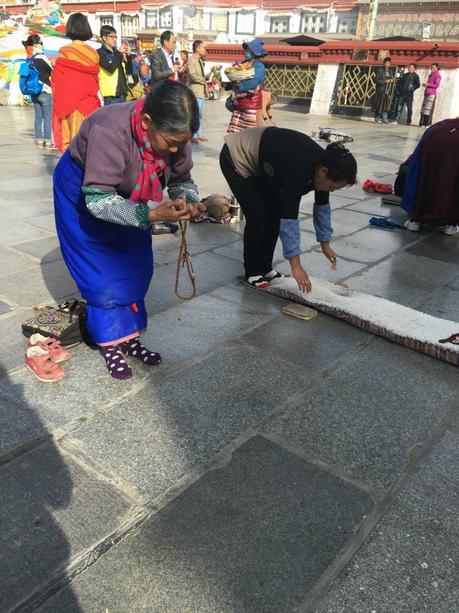
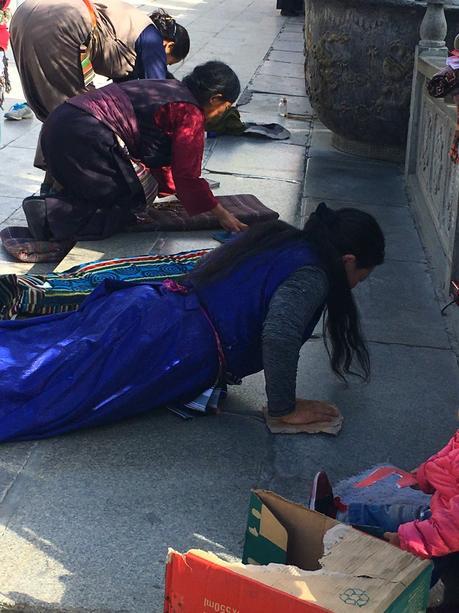
We step inside the temple — confronted again by a plethora of rich, bold colours cascading from the roof to the floor, in the shape of murals, sculptures and statues. We squeeze through the worshippers admiring the setting and then climb up steep stairs, emerging onto the rooftop and what feels like a scene straight out of the Mediterranean, except instead of overlooking the azure blue sea, from this golden rooftop – a 360 degree view of spectacular mountain peaks.
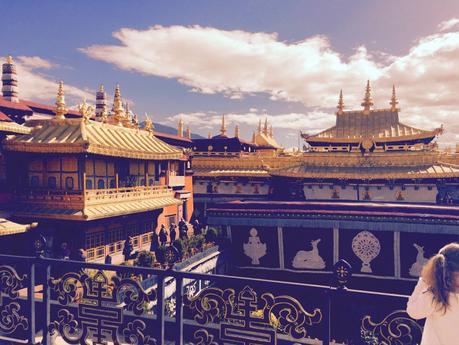
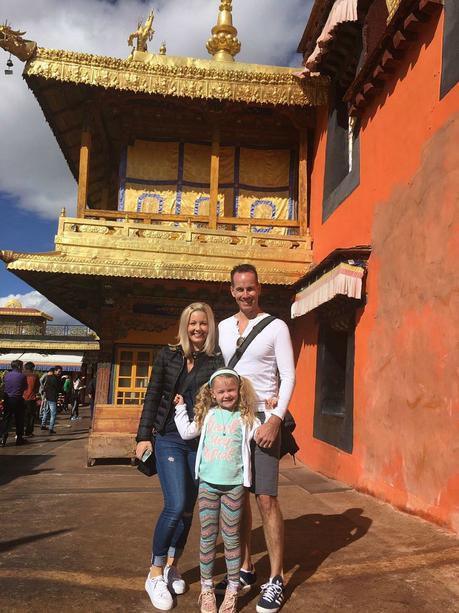
Later, we spend time wandering through the masses and the mazes that make up the Bazaar, the oldest streets in Lhasa.… Almost everyone who passes seems taken aback by the three of us (who can blame them), ;P but mostly by the Small Person…we’ve played right into the locals hands and had our hair braided with colourful cotton in the mall, so we really have no hope of remaining incognito! All of the locals wear floppy hats and I notice, many of them still have the ubiquitous flushed, red cheeks. Some tells us it’s the lack of vegetables this meat-eating culture has had access to in the past. More research and I find out it’s due to the high elevation, intense ultra-violet rays and extreme temperature difference between the days and nights.
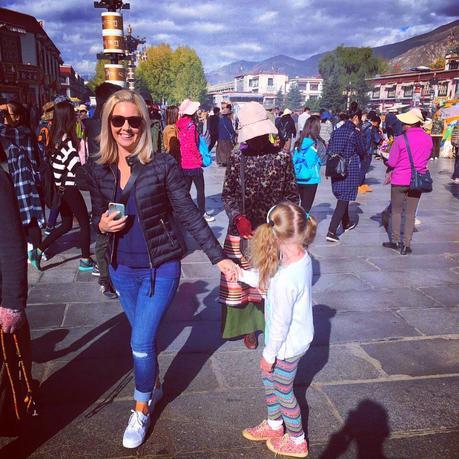
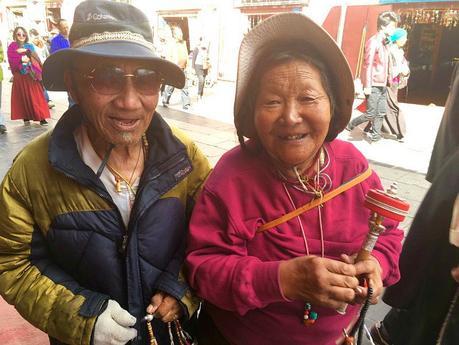
The narrow lane ways shadowed by traditional tibetan homes lead to markets piled high with lumps of yak meat, and pounds of yak butter for sale!
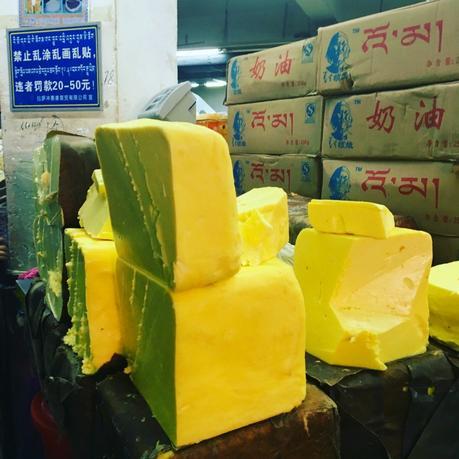
The mighty Yak is unique to the Tibetan Plateau and has played a significant role in Tibetan’s daily lives for thousands of years. Locals eat the meat, drink the milk and make yak cheese, butter, yoghurt and tea. It’s also used as offerings to help burn traditional butter lamps in monasteries. The outer hair of the yak is woven into tent fabric and rope, and the soft inner wool is spun into a type of felt. Yak hide is used for the soles of boots and yak dung is a fundamental fuel.
Trivial Fact: Yaks have three times more red blood cells than normal cows so they are able to live without any problems on the high elevation.
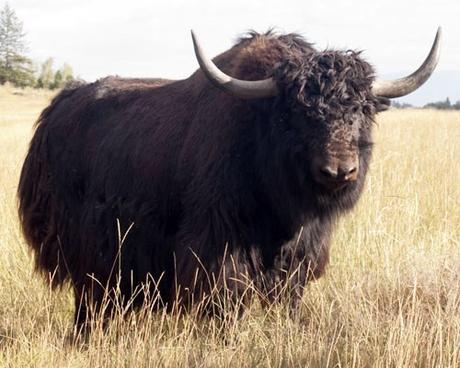
There are rows upon rows of cluttered market stalls selling everything from beads to boots, thick carpets, even extra long hair braids, should you require one!
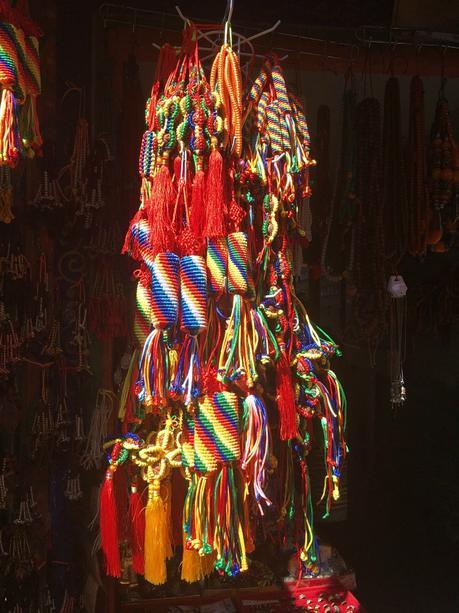

Later that day we get our time for the famous Potala Palace. (There’s now a quota on the number of daily visitors and the travel agent must register you and passports need to be shown on arrival. From the time you enter the palace, you have exactly one hour to see everything.)
We have been looking on in awe at Lhasa’s most iconic landmark from our hotel room for the past two days. As the sun rises over it in the morning to its brightly lit facade at night, this world heritage site is a remarkable piece of architecture. For the Small Person it could easily be a castle straight out of her favourite fairytale.
As Chief Residence for the Dalai Lamas during the winter, the palace has 1000 rooms, 10,000 shrines and about 200,000 statues….
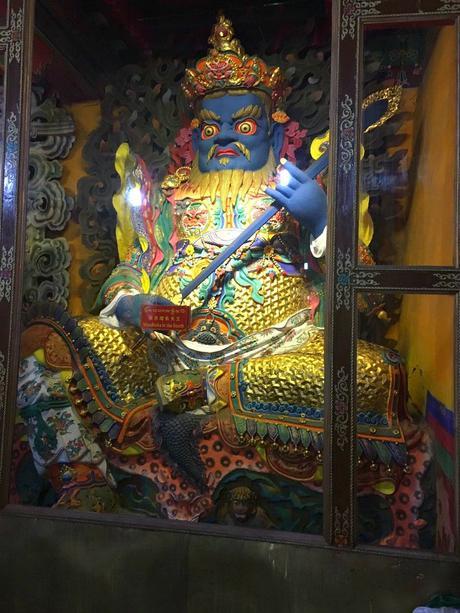
It’s construction began in 1645 by the 5th Dalai Lama, it’s sloping stone walls average three metres thick, and five metres thick at the base. It has copper poured into the foundations to help proof it against earthquakes. Roaming the hallways, I can imagine it gets cold in Tibet’s harsh winters.
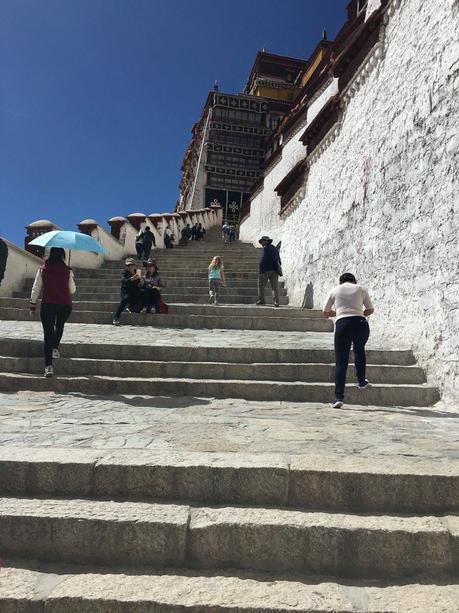
Climbing the 300 steps to the top, at 12,000 feet altitude is no mean feat! The Small Person though is literally skipping to the top.
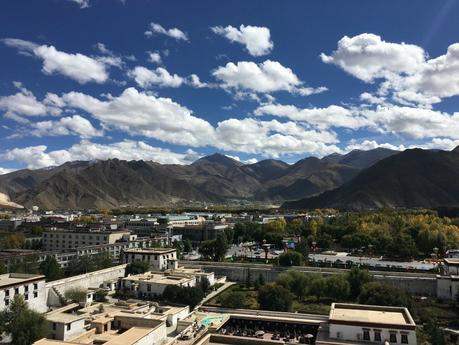
Inside is a literal treasure trove of shrines and thrones, what impresses me most are the tombs of some of the Dalai Lama. That of the 7th Dalai Lama who is seen as “The Great One” is encased in over 4000 kilograms of gold!!
In what is probably one of the most poignant moments of our journey, when we enter one of the oldest and most sacred rooms in the palace, we are overwhelmed and humbled when a monk spies our Small Person amongst the hoards of tourists and comes over to bestow on her a yellow, silk prayer scarf. In the spirit of offering he ties it around her neck in a symbol of long life. It’s one of those moments you know is to be forever treasured.
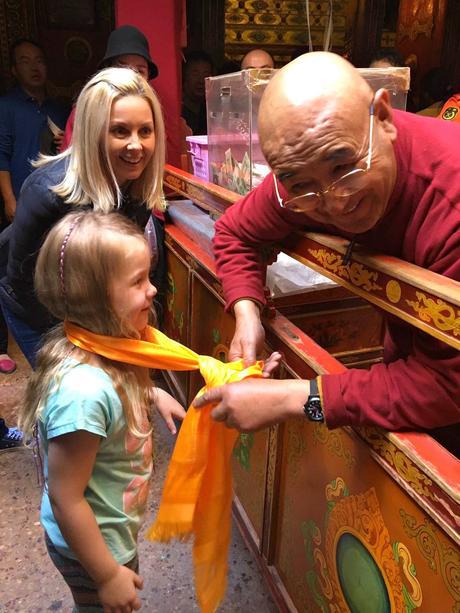
On a high, literally, we come down to ground level with a majestic thud.
Day 4: We are deemed suitably acclimatised to drive high up into the mountains. Small Person’s biggest hope is to see a real, live Yak. Fortunately, we see plenty as the car steadily climbs the steep hill. The big, hairy beasts are dotted across the mountain farms, jingling their cow bells.
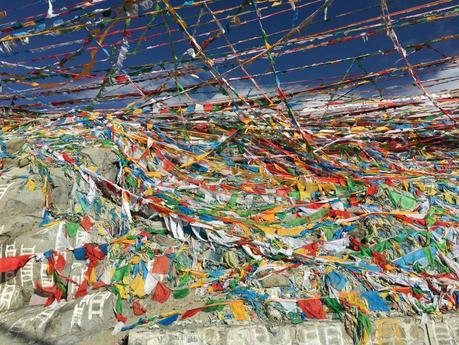
A little later, we come to a halt on the side of the road and are enthralled by what can only be described as an incredible rainbow rooftop under a vibrant blue sky!
Thousands of prayer flags make up this giant kaleidoscope of colour! Draped across the highway, they are a splash of colour against the coarse mountain side.
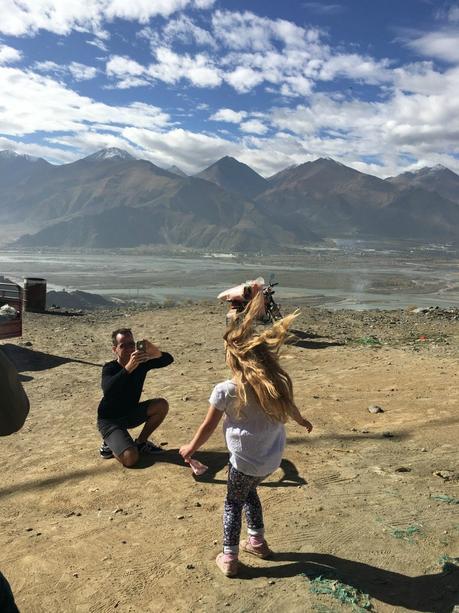
We continue the journey, zig-zagging all the way up into the mountains to the “Drak Yerpa” where we see some of the oldest spiritual sites in Tibet!
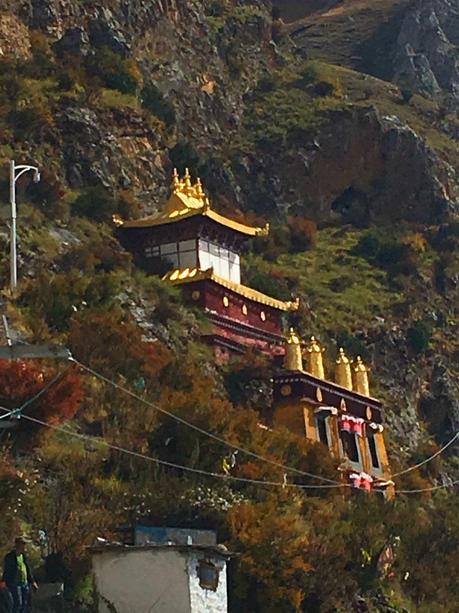
We’re a little reluctant and apprehensive when Lobsang tells us matter of factly, we are going to climb up to that temple! Yes! That one – up there!!
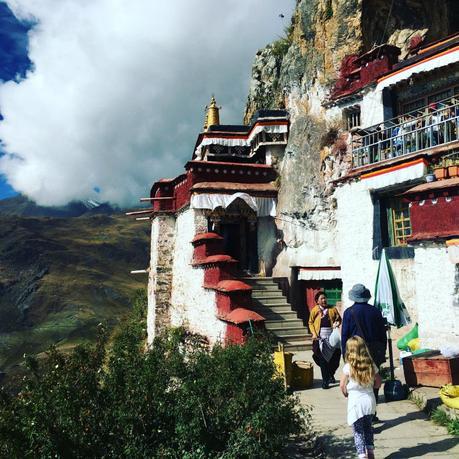
If we thought climbing up to the Potala Palace was a steep trek, this is much tougher. With the attitude now at almost 5000 metres (14000 feet), the struggle is real. Huffing and puffing our way up, we eventually make it to the top and again, this place, described as the “life tree” or “spiritual axis of Lhasa” is truly worth the effort.

With very few tourists, it’s reminiscent of a tiny village perched on the side of the limestone cliffs. We see local monks and residents quietly going about their day. We get to peek inside several tiny meditation caves, hermitages and shrines that are slowly being restored after being damaged during the Cultural Revolution.
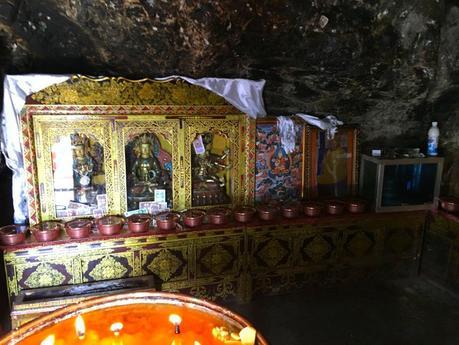
Our guide is spectacular at keeping the Small Person enthralled with the different Buddhas…at one point, they roam from temple to templem counting the auspicious, gold water offering bowls at each alter, while we can’t get enough of the scenery before us.
There’s no doubt, Tibet is place that has captured each of our souls.
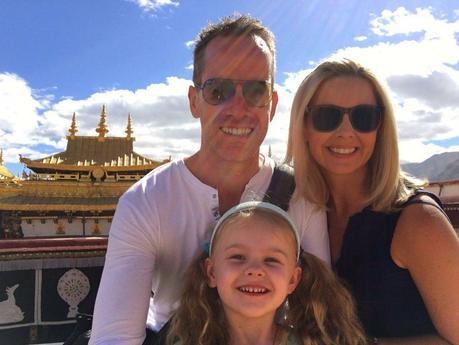
An exotic, spiritual and remarkable spot at the top of the world, where despite all that has happened, centuries old traditions remain and time stands still.
This is Tibet.
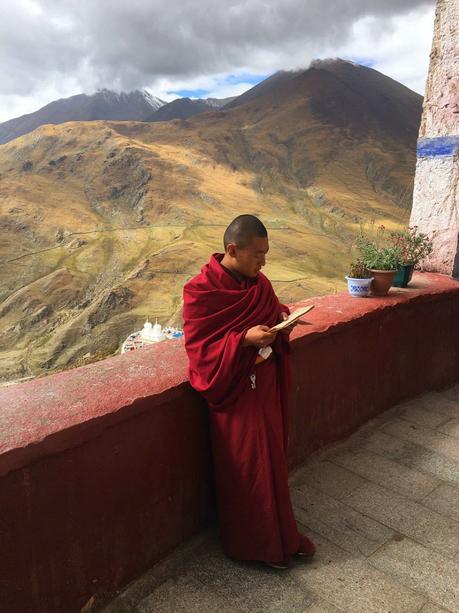
Tour Tibet
(One of the reasons we were able to travel to Tibet with relative ease is because the owners of the Westin Xi’an also own the St Regis Hotel in Lhasa. The team’s help naturally made it immeasurably easier for us to source what we needed.)
What you need to know:
- A Special Permit to enter if you are a foreign citizen, an overseas Chinese citizen without a Chinese passport, or a Taiwanese Citizen. (Allow three weeks for this.) The permit is no cost but expect a charge from your travel agency for arranging the permits.
- Chinese Visa
- If you are working in China, the following is required:
- 1) a current Residence Permit (居留许可证, like a visa in your passport)
- 2) certification in Chinese from your company/school in China (工作证明, using your company’s letter head, with your name and passport number, and company seal on it).
- Everyone needs a confirmed itinerary with an approved Tibet Tour Operator + a tour guide. (You can either travel in a tour group or one man guided tour.) We used St Regis Hotel’s in-house travel agency – Green Source Travel Service Ltd.
- Driver/Car
- An Aliens’ Travel Permit is required to travel to most areas outside Lhasa. You can only obtain it after you arrive in Tibet
Costs:
- Tibet is not a cheap destination to fly to. Flights from within mainland China can be anywhere from RMB1500 to RMB4000, so it pays to choose your travel times and avoid peak season. *Tibet is closed to tourists in February/March.
- Transportation/driver from pick up and drop off at the airport to travelling around Lhasa x 5 days RMB900
- Tour Guide x 3 days (including pick up and drop off at airport) RMB2,500
Where to Go:
- There are a number of tours to Tibet – check this link.
- Individual sites include:
- Drepung Monastery: CNY55 Opening Hours: 9am-5pm — With an area of more than 200,000 m2, Drepung meaning “Rice Heap” in Tibetan, has been the largest and richest Monastery with lots of cultural and religious relics in Tibet since its founding. It used to be the residence of the Dalai Lama, prior to the Potala Palace.
- Sera Monastery: CNY55 Opening Hours 9am-4pm — The Monastery is now residence for several hundred Lamas and a major training centre. Its famous debating activities are happening at 3 – 4pm most days.
- Summer Palace/Norbulingka: CNY80 – Opening Hours: 09:00 to 12:00 in the morning, 15: 00 to 16:00 in the afternoon — Norbulingka Means “Treasure Park” in Tibetan, with 374 rooms and more then 30,000 cultural relics inside, blends gardening with architecture and sculpture arts. It used to be the summer residence of the Dalai Lama until its opening to the public in 1959.
- Tibet Museum: Free (closed Monday’s) The museum is located in the southeast corner of Norbulingka. Covering an area of 53,959 square meters it is the first museum with modern facilities in all of Tibet. The Tibet Museum consists of a prelude hall, main exhibit halls and a cultural relic storeroom. The entire building presents distinctive characteristics of traditional Tibetan architectural art.
- Jokhang Temple CNY85 Opening Hours: 7am-12pm and 3pm-6:30pm. It is a huge complex building with a combination of Tibetan elements meshed with influences from Nepal, China and India. As the holiest site in Tibet, it holds all major Buddhist ceremonies and the Temple is filled with prostrate pilgrims praying on its open porch.
- Bharkhor Bazaar — It is the oldest street in Lhasa, as well as the most representative. It is a place full of religious atmosphere and a world of exotic articles. Traditional Tibetan houses and narrow lanes in and around the street whisper the stories of old Lhasa.
- Potala Palace
- Opening Hours:
- 08:40 to 17:00 (visitors are not allowed to enter at 16:00)Tickets are sold from 08:40 to 16:00.
Majestically situated on the escarpment of Red Hill, the highest ancient Palace in the world, Potala is not only a Tibetan architectural wonder but also a treasure house for material and articles of Tibetan History, religion, culture and arts. During the high season (May 1 to October 31), all visitors are required to apply for reservation tickets with their valid identity documents, such as ID cards and passports one day in advance before they visit the palace. Each valid ID document can be used only once within a week. The visiting date and exact time, number of visitors and ID document numbers are printed on the reservation tickets. Visitors have to visit the palace at the given date and time. They should go to the main gate to have their reservation tickets and ID documents checked and walk to the ticket office in front of the White Palace to buy the entrance tickets. Then they can start their tour after another security check.
Cost: May 1 to October 31: CNY 200; November 1 to April 30: CNY 100 **Tips: Only 4000 tickets are issued each day and about 100 tickets are issued every 20 minutes. Any kind of liquid is not allowed there, including beverages and mineral water, which yet can be purchase at a cost of CNY10 for one bottle at the hill top.
- Yamdrok Lake RMB40 — 5 hour round trip driving. The lake is located at Nangartse County aside the highway between Lhasa and Gyangtse, 110km away from Lhasa. Yamdrok Yumtso is a normally first seen from the summit of Kamba-la (4900m).The lake lies several hundred meters below the road, and in clear weather is a fabulous shade of deep turquoise. Far in the distance is the huge massif of Mt Nojin Kangtsang(7191m) lakes are considered sacred by Tibetan people, the principle being that they are the dwelling places of protective deities and therefore invested with special spiritual powers. Yamdrok Lake is one of three particularly holy lakes. It is surrounded by snow-capped mountains and fed by numerous small Himalayan streams. The water is the main fresh water source for people in Lhasa, even entire Tibet.
- Drak Yerpa Temple/Zhayeba Monastery RMB25 Drak Yerpa is located on a hillside in Daze County. The entrance to the Yerpa Valley is about 16 kilometres northeast of Lhasa, from here, it is another 10 kilometres to the famous ancient meditation caves in the spectacular limestone cliffs of the Yerpa Valley.
WHERE TO STAY
- Many hotels close during winter, but otherwise there are an increasing number of places to stay
- **Obviously you need to abide by the Buddhist customs inside the temples. No hat, covered shoulders.

